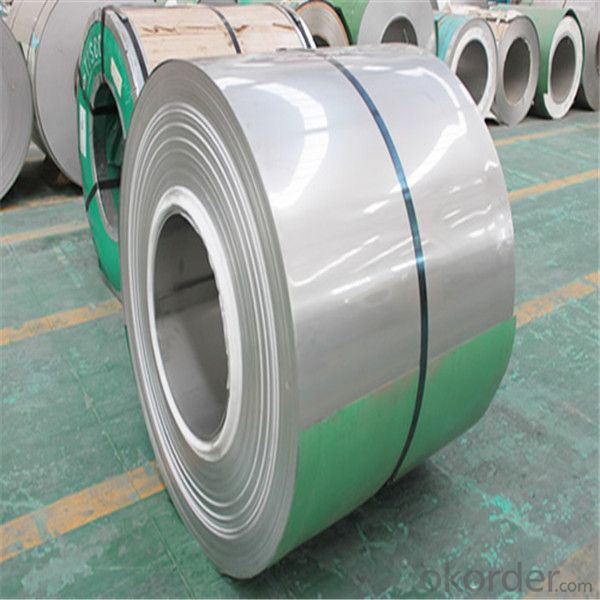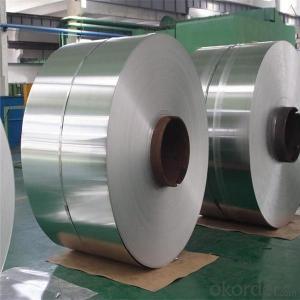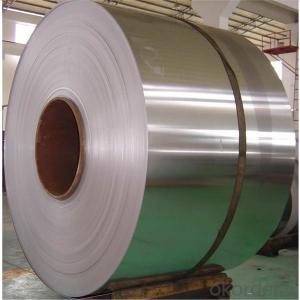201/304/430/ Stainless Steel Coil with good quality
- Loading Port:
- Shanghai
- Payment Terms:
- TT OR LC
- Min Order Qty:
- 5 m.t.
- Supply Capability:
- 24000 m.t./month
OKorder Service Pledge
OKorder Financial Service
You Might Also Like
Item specifice
stainless steel coil
1. Standard: ASTM A240, JIS G4304, G4305, GB/T 4237, GB/T 8165, BS 1449, DIN17460, DIN 17441
2. Grade: 200series&300series&400series
3. Thickness: 0.23mm-0.8mm
4. Diameter: 115-560mm
5. Length: according buyer require
6. Surface finish: 2B, BA, 8K, 6K, Mirror Finished, No1, No2, No4, Hair Line with PVC
7. Manufacture technology: cold drawn/cold rolled/hot rolled
1.Export Markets
Our target market is the international market. Every year we export most of products to countries like India, Pakistan, South Korea, Brazil, Australia, South Africa, Spain, Sri Lanka, russia,vietnam,Taiwan, Hong Kong, etc.
Type | Stainless steel coil (cold rolled ) |
Thinckness | 0.23mm-0.8mm |
Diameter | 115mm-560mm |
Quantity | as customer's requirement |
Finish | 2B,BA,HL,MIRROR,NO.1-NO.4,8K,and so on. |
Standard | ASME, ASTM, EN ,BS,GB,DIN, JIS etc |
Material | 201,202, 301,304,410,430,409 |
Application range | Foodstuff, Gas, metallurgy, biology, electron, chemical, petroleum, boiler, nuclear energy, Medical equipment, fertilizer etc |
Package | Standard export sea-worthy packing |
Delivery time | 7-15 days |
Quality | No.1 |
Productivity | 3000-4000 tons/month |
Note | We can produce other standard as the customers’ requirement |
2.Technical notes:
Surface Finish | Definition | Application |
2B | Those finished, after cold rolling, by heat treatment, pickling or other equivalent treatment and lastly by cold rolling to given appropriate luster. | Medical equipment, Food industry, Construction material, Kitchen utensils. |
BA | Those processed with bright heat treatment after cold rolling. | Kitchen utensils, Electric equipment, Building construction. |
NO.3 | Those finished by polishing with No.100 to No.120 abrasives specified in JIS R6001. | Kitchen utensils, Building construction. |
NO.4 | Those finished by polishing with No.150 to No.180 abrasives specified in JIS R6001. | Kitchen utensils, Building construction, Medical equipment. |
HL | Those finished polishing so as to give continuous polishing streaks by using abrasive of suitable grain size. | Building Construction. |
NO.1 | The surface finished by heat treatment and pickling or processes corresponding there to after hot rolling. | Chemical tank, pipe |
3.chemcial composition
Quality | Copper | NI | CU | Application |
PURE DDQ
| High | 1% | 1.4% | Sink, Deep drawing product |
DDQ | Middle | 1% | 1% | Pot, Bowl |
non-DDQ | Low | 0.5% | 0.5% | Plate, Bowl |


- Q:How are stainless steel strips made?
- The production of stainless steel strips involves a technique called cold rolling, wherein a stainless steel coil is passed through a set of rollers at room temperature. This action progressively reduces the thickness and increases the length of the coil. To begin, the stainless steel coil is unwound and cleaned to eliminate any dirt or impurities. Subsequently, it is subjected to a series of rolling mills where the thickness is gradually decreased. These mills consist of two or more rollers that apply pressure to the metal, causing it to elongate and become thinner. This process is repeated until the desired thickness is achieved. As the stainless steel strip becomes thinner, it becomes more rigid and challenging to handle. To counteract this issue, annealing is conducted at specific intervals during the rolling process. Annealing involves heating the strip to high temperatures and slowly allowing it to cool. This procedure helps alleviate internal stresses and enhance the strip's ductility. Following the cold rolling and annealing stages, the stainless steel strip may undergo additional treatments such as descaling, pickling, and passivating. Descaling eliminates any scales or oxides that may have formed on the strip's surface during rolling. Pickling involves treating the strip with an acid solution to eliminate any remaining impurities. Passivation is the final step, in which a thin, protective oxide layer is formed on the surface of the stainless steel, enhancing its corrosion resistance. Once all of these processes are completed, the stainless steel strip is cut to the desired length and packaged for shipment or further processing. Its exceptional strength, durability, and resistance to corrosion make it suitable for a wide range of applications, including automotive components, kitchen appliances, construction materials, and electronic devices.
- Q:Can stainless steel strips be used in the nuclear industry?
- Yes, stainless steel strips can be used in the nuclear industry. Stainless steel is a popular material choice for various applications in the nuclear industry due to its excellent corrosion resistance and mechanical properties. It is commonly used in the construction of nuclear power plants, nuclear reactors, and related equipment. Stainless steel strips are used in the nuclear industry for a range of purposes. For instance, they can be used in the fabrication of nuclear fuel assemblies, which are crucial components of nuclear reactors. These fuel assemblies house the fuel rods that generate heat through nuclear fission. Stainless steel strips are used to provide structural support and ensure the integrity and safety of the fuel assemblies. Moreover, stainless steel strips are utilized in the construction of containment vessels and pressure vessels in nuclear plants. These vessels are responsible for containing radioactive materials and ensuring the safety of personnel and the surrounding environment. Stainless steel's resistance to corrosion and high-temperature environments makes it an ideal choice for these critical applications. Additionally, stainless steel strips are used in the manufacturing of various components such as piping systems, heat exchangers, valves, and pumps within nuclear facilities. These components require materials that can withstand harsh operating conditions, including high temperatures, radiation exposure, and corrosive environments. Stainless steel's durability and resistance to corrosion make it a reliable material for these applications. Overall, stainless steel strips are widely used in the nuclear industry due to their excellent properties, making them suitable for various applications. The industry relies on stainless steel's corrosion resistance, mechanical strength, and high-temperature tolerance to ensure the safety and efficiency of nuclear power generation.
- Q:How do stainless steel strips compare to other metals in terms of cost?
- Stainless steel strips tend to be more expensive than other metals due to their durability, corrosion resistance, and high-quality properties.
- Q:Can stainless steel strips be used for metal stamping?
- Yes, stainless steel strips can be used for metal stamping. Stainless steel is a popular choice for metal stamping due to its high strength, corrosion resistance, and durability. It is commonly used for various applications such as automotive parts, appliances, and electrical components. Stainless steel strips can be easily formed, bent, and stamped into different shapes and sizes using metal stamping techniques. The characteristics of stainless steel, such as its hardness and resistance to wear, make it suitable for producing precise and intricate designs through metal stamping processes. Overall, stainless steel strips are a versatile material that can be effectively utilized for metal stamping purposes.
- Q:How do stainless steel strips perform in cryogenic environments?
- The outstanding performance of stainless steel strips in cryogenic environments is well-known. Stainless steel strips possess exceptional resistance to extreme low temperatures, thanks to their unique composition and properties. In cryogenic temperatures, stainless steel strips exhibit remarkable strength, toughness, and corrosion resistance, rendering them highly suitable for a wide range of applications. Even under extremely cold conditions, stainless steel maintains its mechanical properties without becoming brittle or cracking, ensuring the structural integrity of the material. The corrosion resistance of stainless steel is particularly advantageous in cryogenic environments, where moisture and other corrosive elements can be present. The formation of a passive oxide layer on the surface of stainless steel protects it from chemical reactions and oxidation, guaranteeing its durability and longevity in cryogenic applications. Moreover, stainless steel strips possess excellent thermal conductivity, facilitating efficient heat transfer in cryogenic systems. This is especially beneficial in applications like cryogenic storage tanks, where maintaining the temperature of stored materials is crucial. Overall, stainless steel strips exhibit exceptional performance in cryogenic environments, combining strength, toughness, corrosion resistance, and thermal conductivity. These properties make stainless steel the preferred choice in various industries, including aerospace, energy, medical, and research, where cryogenic conditions are prevalent.
- Q:What are the different types of surface treatments for stainless steel strips?
- There are several different types of surface treatments available for stainless steel strips, each offering unique benefits and characteristics. 1. Pickling: This is a chemical treatment that involves immersing the stainless steel strips in an acid solution, such as nitric or hydrochloric acid. Pickling removes surface impurities and contaminants, resulting in a clean and smooth surface finish. 2. Passivation: Passivation is a process that creates a protective oxide layer on the surface of stainless steel strips, enhancing their corrosion resistance. This treatment is typically performed by immersing the strips in a nitric acid solution or applying a citric acid paste. 3. Electropolishing: This is an electrochemical process that removes a thin layer of material from the stainless steel strips, resulting in a smooth and shiny surface finish. Electropolishing not only improves the aesthetic appearance but also enhances the corrosion resistance and cleanability of the strips. 4. Brushing: Brushing involves using abrasive materials, such as wire brushes or abrasive pads, to create a brushed or satin finish on the stainless steel strips. This treatment can help to mask any surface imperfections and provide a decorative and uniform appearance. 5. Grinding: Grinding is a mechanical process that uses abrasive wheels or belts to remove material from the surface of the stainless steel strips. This treatment can be used to achieve a specific surface roughness or to remove any defects or blemishes. 6. Coating: Coating the surface of stainless steel strips with a protective material, such as paint or powder coating, can provide additional corrosion resistance and improve the aesthetic appearance. Coatings are available in a wide range of colors and finishes. 7. Polishing: Polishing involves using abrasive materials, such as polishing compounds or buffing wheels, to create a mirror-like finish on the stainless steel strips. This treatment enhances the appearance of the strips and can also improve their corrosion resistance. Each of these surface treatments offers different advantages depending on the desired outcome and application requirements. It is important to consider factors such as corrosion resistance, aesthetics, and functionality when selecting the appropriate treatment for stainless steel strips.
- Q:What are the different types of corrosion that can affect stainless steel strips?
- Stainless steel strips can be affected by various types of corrosion. Let's explore these different types: 1. General corrosion: The surface of the stainless steel strip undergoes a uniform attack, resulting in a widespread loss of material. This happens when the protective oxide layer on the stainless steel gets damaged or compromised, usually due to exposure to aggressive chemicals or high temperatures. 2. Pitting corrosion: Localized corrosion occurs, creating small pits or holes on the surface of the stainless steel strip. This happens when specific aggressive chemicals or environments penetrate the protective oxide layer, causing localized breakdown and corrosion. 3. Crevice corrosion: Corrosion takes place in narrow gaps or crevices on the stainless steel strip, such as those between overlapping materials or under gaskets. These crevices provide an environment where aggressive chemicals can accumulate, leading to localized corrosion. 4. Stress corrosion cracking (SCC): This type of corrosion occurs under tensile stress while being exposed to a corrosive environment. It can cause the stainless steel strip to fail suddenly, even at stress levels lower than its yield strength. SCC is often associated with exposure to certain chemicals or environments, such as chlorides or sulfides. 5. Intergranular corrosion: Grain boundaries of the stainless steel strip are affected, resulting in localized corrosion along these boundaries. This occurs when the stainless steel is exposed to certain conditions, such as high temperatures or welding, which can cause sensitization and subsequent corrosion along the grain boundaries. 6. Galvanic corrosion: When stainless steel comes into electrical contact with a different metal in the presence of an electrolyte like water or saltwater, galvanic corrosion occurs. The electrical potential difference between the two metals leads to accelerated corrosion of the less noble metal (in this case, stainless steel). To ensure the longevity and performance of stainless steel strips, it is crucial to consider these various types of corrosion when selecting the appropriate stainless steel grade and implementing proper corrosion prevention measures.
- Q:What is the thermal conductivity of stainless steel strips at different temperatures?
- The thermal conductivity of stainless steel strips can vary depending on the specific grade of stainless steel and the temperature at which it is measured. However, in general, stainless steel is known for its relatively low thermal conductivity compared to other metals. At room temperature (around 25°C or 77°F), the thermal conductivity of stainless steel strips typically ranges from 14 to 19 watts per meter-kelvin (W/m·K). As the temperature increases, the thermal conductivity of stainless steel tends to decrease slightly. For example, at elevated temperatures such as 200°C (392°F), the thermal conductivity of stainless steel may decrease to around 12 to 17 W/m·K. Similarly, at extremely high temperatures, such as 1000°C (1832°F), the thermal conductivity of stainless steel can further decrease to approximately 8 to 12 W/m·K. It is important to note that these values are approximate and can vary depending on factors such as the specific alloy composition, impurities, and processing methods used in manufacturing the stainless steel strips. Therefore, for accurate and precise thermal conductivity values at different temperatures, it is recommended to consult the technical datasheet or contact the manufacturer of the specific stainless steel strip being used.
- Q:What are the common product forms in which 111 stainless steel strips are available?
- Various product forms of 111 stainless steel strips are readily available to meet different applications and needs. These include coils, sheets, slit strips, precision strips, flat bars, and foils. Coils are commonly used in automotive, construction, and appliances industries. They offer convenience to manufacturers as they can be easily shaped and sized. Sheets are used in architectural applications, kitchen equipment, and for decorative purposes. They can be easily cut, bent, and formed according to specific requirements. Slit strips are narrow and long, and commonly used in applications such as gaskets, seals, and electrical components. They come in various thicknesses and widths to suit specific needs. Precision strips are manufactured with tight tolerances and high surface quality. They are used in critical applications where precise dimensions and superior surface finish are required, such as in the medical and aerospace industries. Flat bars, which provide strength and stability, are widely used in structural applications, support frames, and machine components. They offer a larger surface area for load distribution. Foil-form stainless steel strips are thin and flexible, commonly used in packaging, electronic components, and heat exchangers. They provide excellent corrosion resistance and can be easily molded into complex shapes. It is important to consider that the availability of these product forms may vary depending on the manufacturer and specific industry requirements.
- Q:Are stainless steel strips suitable for heat treatment processes?
- Yes, stainless steel strips are suitable for heat treatment processes. Heat treatment is a common process used to modify the physical and mechanical properties of metals, including stainless steel. By subjecting stainless steel strips to controlled heating and cooling cycles, it is possible to alter their hardness, strength, and other properties to meet specific requirements. Heat treatment processes such as annealing, quenching, tempering, and precipitation hardening can be applied to stainless steel strips to improve their machinability, formability, and resistance to corrosion. However, it is important to consider the specific grade and composition of stainless steel being used, as some grades may have limitations on the extent of heat treatment that can be applied. Consulting with a metallurgist or material specialist is recommended to ensure the appropriate heat treatment process is selected for specific stainless steel strips.
1. Manufacturer Overview |
|
|---|---|
| Location | |
| Year Established | |
| Annual Output Value | |
| Main Markets | |
| Company Certifications | |
2. Manufacturer Certificates |
|
|---|---|
| a) Certification Name | |
| Range | |
| Reference | |
| Validity Period | |
3. Manufacturer Capability |
|
|---|---|
| a)Trade Capacity | |
| Nearest Port | |
| Export Percentage | |
| No.of Employees in Trade Department | |
| Language Spoken: | |
| b)Factory Information | |
| Factory Size: | |
| No. of Production Lines | |
| Contract Manufacturing | |
| Product Price Range | |
Send your message to us
201/304/430/ Stainless Steel Coil with good quality
- Loading Port:
- Shanghai
- Payment Terms:
- TT OR LC
- Min Order Qty:
- 5 m.t.
- Supply Capability:
- 24000 m.t./month
OKorder Service Pledge
OKorder Financial Service
Similar products
New products
Hot products
Related keywords



























